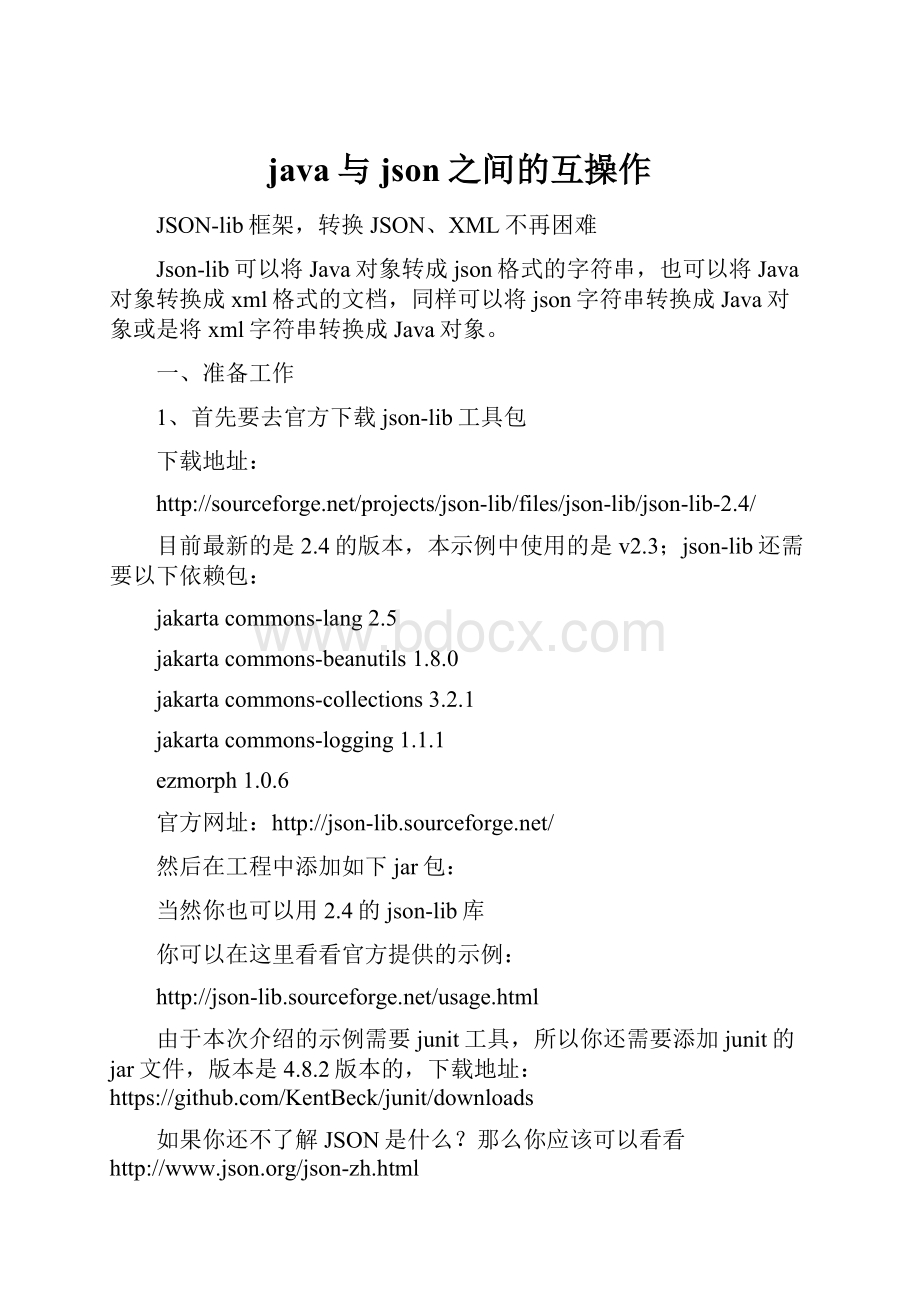java与json之间的互操作.docx
《java与json之间的互操作.docx》由会员分享,可在线阅读,更多相关《java与json之间的互操作.docx(33页珍藏版)》请在冰豆网上搜索。

java与json之间的互操作
JSON-lib框架,转换JSON、XML不再困难
Json-lib可以将Java对象转成json格式的字符串,也可以将Java对象转换成xml格式的文档,同样可以将json字符串转换成Java对象或是将xml字符串转换成Java对象。
一、准备工作
1、首先要去官方下载json-lib工具包
下载地址:
目前最新的是2.4的版本,本示例中使用的是v2.3;json-lib还需要以下依赖包:
jakartacommons-lang2.5
jakartacommons-beanutils1.8.0
jakartacommons-collections3.2.1
jakartacommons-logging1.1.1
ezmorph1.0.6
官方网址:
http:
//json-
然后在工程中添加如下jar包:
当然你也可以用2.4的json-lib库
你可以在这里看看官方提供的示例:
http:
//json-
由于本次介绍的示例需要junit工具,所以你还需要添加junit的jar文件,版本是4.8.2版本的,下载地址:
如果你还不了解JSON是什么?
那么你应该可以看看http:
//www.json.org/json-zh.html
2、要转换的JavaBean的代码如下:
packagecom.hoo.entity;
publicclassStudent{
privateintid;
privateStringname;
privateStringemail;
privateStringaddress;
privateBirthdaybirthday;
//setter、getter
publicStringtoString(){
returnthis.name+"#"+this.id+"#"+this.address+"#"+this.birthday+"#"+this.email;
}
}
Birthday.java
packagecom.hoo.entity;
publicclassBirthday{
privateStringbirthday;
publicBirthday(Stringbirthday){
super();
this.birthday=birthday;
}
//setter、getter
publicBirthday(){}
@Override
publicStringtoString(){
returnthis.birthday;
}
}
注意,上面的getter、setter方法省略了,自己构建下。
3、新建JsonlibTest测试类,基本代码如下:
packagecom.hoo.test;
importjava.lang.reflect.InvocationTargetException;
importjava.util.ArrayList;
importjava.util.Collection;
importjava.util.Date;
importjava.util.HashMap;
importjava.util.Iterator;
importjava.util.List;
importjava.util.Map;
importjava.util.Set;
importnet.sf.json.JSON;
importnet.sf.json.JSONArray;
importnet.sf.json.JSONFunction;
importnet.sf.json.JSONObject;
importnet.sf.json.JSONSerializer;
importnet.sf.json.JsonConfig;
importnet.sf.json.processors.JsonValueProcessor;
importnet.sf.json.util.PropertyFilter;
importnet.sf.json.xml.XMLSerializer;
importmons.beanutils.PropertyUtils;
importorg.junit.After;
importorg.junit.Before;
importorg.junit.Test;
importcom.hoo.entity.Birthday;
importcom.hoo.entity.Student;
/**
*function:
用json-lib转换java对象到JSON字符串
*读取json字符串到java对象,序列化jsonObject到xml
*json-lib-version:
json-lib-2.3-jdk15.jar
*依赖包:
*commons-beanutils.jar
*commons-collections-3.2.jar
*ezmorph-1.0.3.jar
*commons-lang.jar
*commons-logging.jar
*@authorhoojo
*@createDateNov28,20102:
28:
39PM
*@fileJsonlibTest.java
*@packagecom.hoo.test
*@projectWebHttpUtils
*@blog
*@emailhoojo_@
*@version1.0
*/
@SuppressWarnings({"deprecation","unchecked"})
publicclassJsonlibTest{
privateJSONArrayjsonArray=null;
privateJSONObjectjsonObject=null;
privateStudentbean=null;
@Before
publicvoidinit(){
jsonArray=newJSONArray();
jsonObject=newJSONObject();
bean=newStudent();
bean.setAddress("address");
bean.setEmail("email");
bean.setId
(1);
bean.setName("haha");
Birthdayday=newBirthday();
day.setBirthday("2010-11-22");
bean.setBirthday(day);
}
@After
publicvoiddestory(){
jsonArray=null;
jsonObject=null;
bean=null;
System.gc();
}
publicfinalvoidfail(Stringstring){
System.out.println(string);
}
publicfinalvoidfailRed(Stringstring){
System.err.println(string);
}
}
上面的init会在每个方法之前运行,destory会在每个方法完成后执行。
分别用到了junit的@Before、@After注解,如果你对junit的这些注解不是很了解,可以看看junit官方的测试用例的example和doc;
JSONObject是将Java对象转换成一个json的Object形式,JSONArray是将一个Java对象转换成json的Array格式。
那什么是json的Object形式、Array形式?
用通俗易懂的方法将,所谓的json的Object形式就是一个花括号里面存放的如JavaMap的键值对,如:
{name:
’hoojo’,age:
24};
那么json的Array形式呢?
就是中括号,括起来的数组。
如:
[‘json’,true,22];
如果你还想了解更多json方面的知识,请看:
http:
//www.json.org/json-zh.html
除了上面的JSONArray、JSONObject可以将Java对象转换成JSON或是相反,将JSON字符串转换成Java对象,还有一个对象也可以完成上面的功能,它就是JSONSerializer;下面我们就来看看它们是怎么玩转Java对象和JSON的。
二、Java对象序列化成JSON对象
1、将JavaObject转换吃JSON字符串
在JsonlibTest中添加如下代码:
/*=========================JavaObject>>>>JSONString===========================*/
/**
*function:
转JavaBean对象到JSON
*@authorhoojo
*@createDateNov28,20102:
35:
54PM
*/
@Test
publicvoidwriteEntity2JSON(){
fail("==============JavaBean>>>JSONObject==================");
fail(JSONObject.fromObject(bean).toString());
fail("==============JavaBean>>>JSONArray==================");
fail(JSONArray.fromObject(bean).toString());//array会在最外层套上[]
fail("==============JavaBean>>>JSONObject==================");
fail(JSONSerializer.toJSON(bean).toString());
fail("========================JsonConfig========================");
JsonConfigjsonConfig=newJsonConfig();
jsonConfig.registerJsonValueProcessor(Birthday.class,newJsonValueProcessor(){
publicObjectprocessArrayValue(Objectvalue,JsonConfigjsonConfig){
if(value==null){
returnnewDate();
}
returnvalue;
}
publicObjectprocessObjectValue(Stringkey,Objectvalue,JsonConfigjsonConfig){
fail("key:
"+key);
returnvalue+"##修改过的日期";
}
});
jsonObject=JSONObject.fromObject(bean,jsonConfig);
fail(jsonObject.toString());
Studentstudent=(Student)JSONObject.toBean(jsonObject,Student.class);
fail(jsonObject.getString("birthday"));
fail(student.toString());
fail("#####################JsonPropertyFilter############################");
jsonConfig.setJsonPropertyFilter(newPropertyFilter(){
publicbooleanapply(Objectsource,Stringname,Objectvalue){
fail(source+"%%%"+name+"--"+value);
//忽略birthday属性
if(value!
=null&&Birthday.class.isAssignableFrom(value.getClass())){
returntrue;
}
returnfalse;
}
});
fail(JSONObject.fromObject(bean,jsonConfig).toString());
fail("#################JavaPropertyFilter##################");
jsonConfig.setRootClass(Student.class);
jsonConfig.setJavaPropertyFilter(newPropertyFilter(){
publicbooleanapply(Objectsource,Stringname,Objectvalue){
fail(name+"@"+value+"#"+source);
if("id".equals(name)||"email".equals(name)){
value=name+"@@";
returntrue;
}
returnfalse;
}
});
//jsonObject=JSONObject.fromObject(bean,jsonConfig);
//student=(Student)JSONObject.toBean(jsonObject,Student.class);
//fail(student.toString());
student=(Student)JSONObject.toBean(jsonObject,jsonConfig);
fail("Student:
"+student.toString());
}
fromObject将Java对象转换成json字符串,toBean将json对象转换成Java对象;
上面方法值得注意的是使用了JsonConfig这个对象,这个对象可以在序列化的时候对JavaObject的数据进行处理、过滤等
上面的jsonConfig的registerJsonValueProcessor方法可以完成对象值的处理和修改,比如处理生日为null时,给一个特定的值。
同样setJsonPropertyFilter和setJavaPropertyFilter都是完成对转换后的值的处理。
运行上面的代码可以在控制台看到如下结果:
==============JavaBean>>>JSONObject==================
{"address":
"address","birthday":
{"birthday":
"2010-11-22"},"email":
"email","id":
1,"name":
"haha"}
==============JavaBean>>>JSONArray==================
[{"address":
"address","birthday":
{"birthday":
"2010-11-22"},"email":
"email","id":
1,"name":
"haha"}]
==============JavaBean>>>JSONObject==================
{"address":
"address","birthday":
{"birthday":
"2010-11-22"},"email":
"email","id":
1,"name":
"haha"}
========================JsonConfig========================
key:
birthday
{"address":
"address","birthday":
"2010-11-22##修改过的日期","email":
"email","id":
1,"name":
"haha"}
2010-11-22##修改过的日期
haha#1#address#null#email
#####################JsonPropertyFilter############################
haha#1#address#2010-11-22#email%%%address--address
haha#1#address#2010-11-22#email%%%birthday--2010-11-22
haha#1#address#2010-11-22#email%%%email--email
haha#1#address#2010-11-22#email%%%id--1
haha#1#address#2010-11-22#email%%%name--haha
{"address":
"address","email":
"email","id":
1,"name":
"haha"}
#################JavaPropertyFilter##################
address@address#null#0#null#null#null
birthday@2010-11-22##修改过的日期#null#0#address#null#null
email@email#null#0#address#null#null
id@1#null#0#address#null#null
name@haha#null#0#address#null#null
Student:
haha#0#address#null#null
2、将JavaList集合转换吃JSON字符串
/**
*function:
转换JavaList集合到JSON
*@authorhoojo
*@createDateNov28,20102:
36:
15PM
*/
@Test
publicvoidwriteList2JSON(){
fail("==============JavaList>>>JSONArray==================");
Liststu=newArrayList();
stu.add(bean);
bean.setName("jack");
stu.add(bean);
fail(JSONArray.fromObject(stu).toString());
fail(JSONSerializer.toJSON(stu).toString());
}
运行此方法后,可以看到控制台输出:
==============JavaList>>>JSONArray==================
[{"address":
"address","birthday":
{"birthday":
"2010-11-22"},"email":
"email","id":
1,"name":
"jack"},
{"address":
"address","birthday":
{"birthday":
"2010-11-22"},"email":
"email","id":
1,"name":
"jack"}]
[{"address":
"address","birthday":
{"birthday":
"2010-11-22"},"email":
"email","id":
1,"name":
"jack"},
{"address":
"address","birthday":
{"birthday":
"2010-11-22"},"email":
"email","id":
1,"name":
"jack"}]
如果你是转换List集合,一定得用JSONArray或是JSONSrializer提供的序列化方法。
如果你用JSONObject.fromObject方法转换List会出现异常,通常使用JSONSrializer这个JSON序列化的方法,它会自动识别你传递的对象的类型,然后转换成相应的JSON字符串。
3、将Map集合转换成JSON对象
/**
*function:
转JavaMap对象到JSON
*@authorhoojo
*@createDateNov28,20102:
37:
35PM
*/
@Test
publicvoidwriteMap2JSON(){
Mapmap=newHashMap();